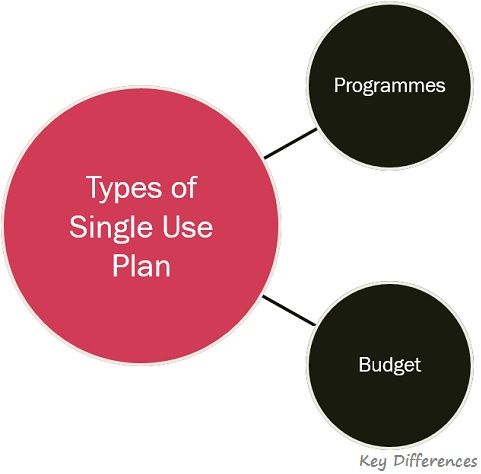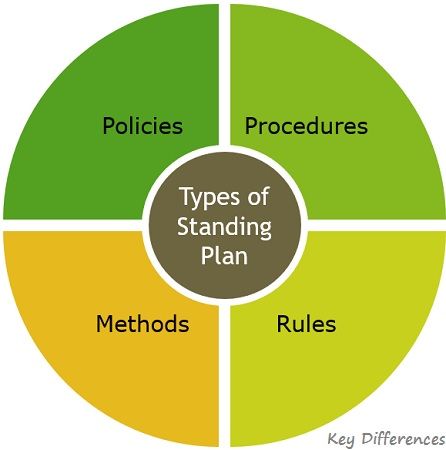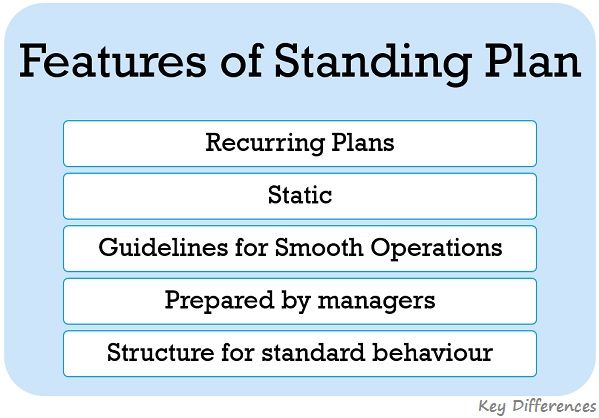 The difference between a single-use plan and the standing plan is clear from their name itself. Single-Use Plan is a type of plan, which can be used only once and so every time a new plan is formulated, to deal with the situation. On the contrary, standing plan implies the plan which is always ready for usage and they have a comparatively long-standing, i.e. once these plans are prepared they can be used for years.
The difference between a single-use plan and the standing plan is clear from their name itself. Single-Use Plan is a type of plan, which can be used only once and so every time a new plan is formulated, to deal with the situation. On the contrary, standing plan implies the plan which is always ready for usage and they have a comparatively long-standing, i.e. once these plans are prepared they can be used for years.
What is a Plan?
In simple words, a plan is a scheme, which outlines how the work is to be performed so as to meet the desired objective.
In an organization, formulation of plans is a very common thing. It is performed to ensure smooth functioning and sound decision making under various circumstances. Now, these plans are grouped into various types depending on their frequency of use. These are Single Use Plan and Standing Plan.
Content: Single-Use Plan Vs Standing Plan
Comparison Chart
| Basis for Comparison | Single Use Plan | Standing Plan |
|---|---|---|
| Meaning | Single-use plans refer to the plans which are designed for one-time usage, i.e. the completion of a project or an event, and it has a particular objective. | Standing plans implies the plans which are formulated for repeated usage, as they are concerned with the situations of the organization which occurs quite often. |
| Acts as | Approach to handle the situation or problem. | Ready guide for action |
| Objective | To effectively accomplish particular activities, projects or events. | To bring uniformity and consistency in decisions. |
| Nature | One time use | Repetitive use |
| Time Period | Short Term | Long term |
| Scope | Narrow | Comparatively Wide |
| Usage | Once the project is complete or the event is finished, these plans are discarded. | These plans are prepared while keeping the future in mind, hence they are used again and again, with relevant modifications and updations, when required. |
| Creation | For a specific end or result, and when the result is achieved or end is reached, the plan is dissolved. | After a deep discussion and analysis of the situation and input from a number of people, who deal with the situation. |
Definition of Single-Use Plan
Single-Use Plans, as the name suggests are the plans which are used only once, as these are developed to attain a specific goal, be it the accomplishment of an event, activity or project. Hence, they are designed in such a way that the needs of the unique situation are met effectively.
- The situation for which these plans are developed is not expected to reoccur in the near future.
- And once the issue is resolved or the event is complete, a new plan takes its place, which is devised for the upcoming events or activities.
- On the basis of the event, project or activity for which the plan is prepared, the length of the single-use plan varies, i.e. it may range from one day to one year or sometimes even longer than a year.
In finer terms, single-use plans are the ones which cannot be used to meet out objectives, other than the objective, it is devised for. These are the plans, which determines beforehand, the future course of action to be undertaken to cope with a particular problem or to handle a situation.
Types of Single Use Plan

For Example, Plan developed for an advertising campaign. Once the advertising campaign is aired, the plan is discarded.
Also Read: Difference Between Strategy and Planning
Definition of Standing Plan
Standing Plans refers to the plan which is designed to cater to the situations or issues that are encountered by the managers repeatedly in an organization. These act as guidelines to the management to handle problems which occur recurrently.
- They are used multiple times, whenever the same situation and problem arises. And thus, it maintains the uniformity and consistency in decisions.
- It is a significant way to develop a predictable behavioural pattern.
- As these plans are meant for immediate guidance, continuous reference and a constant ritual, it facilitates the smooth function of the internal operations of the enterprise.
Moreover, the creation of plans is done only once, however, their value is retained over the years, but these are subjected to timely revisions and updations, based on the exigencies of business. 
For Example, Tardiness is a very common issue in an organization and it is related to the entire workforce of the concern. So, the managers can formulate policy, to correct the behaviour of the employees, and execute the same whenever an employee is late.
Also Read: Difference Between Rules and Policies
Key Differences Between Single Use Plan and Standing Plan
The difference between single-use plan and standing plan can be boiled down in the points given below:
- Single-use plan, as the name suggests are the plans which are devised for single time usage, i.e. for the situation or problem in hand. On the other hand, standing plans imply the plans which are meant for recurrent usage, as well as they are developed to handle those problems and issues which occur in general.
- Single-use plans acts as an approach or strategy developed to handle the situation or problem. As against, standing plans acts as a reference guide or a sketch for action.
- The single-use plan aims at accomplishing the particular activities, projects or events, in an effective manner. On the other hand, standing plans are used to bring uniformity and consistency in actions and decisions.
- Single-use plans are created for one-time usage. As against, standing plans are prepared for repetitive usage.
- Standing plans are generally used over a long period of time, and are modified from time to time, so as to adapt according to the changing circumstances. On the contrary, single-use plans are generally for the short term. However, the length of the plan may vary according to the type of project or event, for which the plan is made.
- When it comes to scope, single-use plans have a limited scope because they are devised to resolve a particular issue or handle a specific situation only, whereas standing plans are designed in such a way that they can be referred in various situations to resolve various issues. Hence, its scope is wide.
- Single-Use Plans becomes obsolete, once the purpose for which they are prepared is served. For example, A firm establishes a target to increase its sales by 20%, from the last quarter. Once the target is achieved, the plan is of no use, hence, it is replaced with a new plan. As against, Standing Plan is prepared to keep the future in of the organization mind, so they are used again and again over the years, with relevant modifications and updations.
- Single-Use Plan is designed for a specific end or result, and when the result is achieved or end is reached, the plan is dissolved. On the contrary, standing plans are prepared after a deep discussion and analysis of the situation and input from a number of people, who deal with the situation.
Features of Single-Use Plans
- One time use
- Formulated to meet the demand for a unique situation.
- Once the project or activity is complete, these are replaced.
- Duration of single-use plan differs according to the type of the project.
- The fresh plan is created every time for a new situation.
Features of Standing Plans
- Recurring plans, used for an indefinite term.
- These are static or permanent in nature.
- It acts as guidelines for the smooth functioning of the concern.
- Prepared by managers, at the top, middle and lower level.
- Set up a structure for standard behaviour to get the desired outcome.
Examples
| Single Use Plan | Standing Plan |
|---|---|
| An Event Management Company prepares a single-use plan for every client, be it a wedding function, new year party, birthday celebration, etc. as per their requirements and budget. | The sales policy of the enterprise, states that the sales will be made on a cash basis only. So, this provides a standing instruction and limitation, to the managers, with regard to the conclusion of sales. |
| An Architectural firm, takes an order from a client, to design their building. As the design prepared is of specialized nature, a similar design cannot be used for other clients. | The specific procedure adopted by the banks to process loan application or to open an account is a standing plan. |
Conclusion
Therefore, we have understood that single-use plans are designed to be implemented in specific or non-recurring circumstances. But on the other hand, standing plans are devised to solve the issues that occur repeatedly and these plans are used over the years.








Leave a Reply